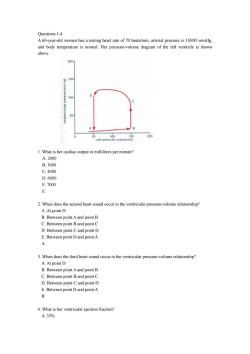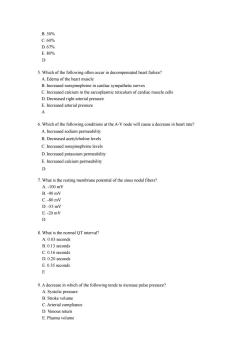同济大学:《生理学》课程教学资源(试卷习题)生理学多选题(三)

Questions 1-4 A 60-year-old women has a resting heart rate of 70 beats/min,arterial pressure is 130/85 mmHg. and body temperature is normal.Her pressure-volume diagram of the left ventricle is shown above. 200 150 1.What is her cardiac output in millilitres per minute? A.2000 B.3000 C.4000 D.6000 E.7000 E 2.When does the second heart sound occur in the ventricular pressure-volume relationship? A.At point D B.Between point Aand point B C.Between point B and point C D.Between point C and point D E.Between point Dand pointA A 3.When does the third heart sound occur in the ventricular pressure-volume relationship? A.At point D B.Between point A and point B C.Between point B and point C D.Between point C and point D E.Between point D and point A B 4.What is her ventricular ejection fraction? A.33%
Questions 1-4 A 60-year-old women has a resting heart rate of 70 beats/min, arterial pressure is 130/85 mmHg, and body temperature is normal. Her pressure-volume diagram of the left ventricle is shown above. 1. What is her cardiac output in millilitres per minute? A. 2000 B. 3000 C. 4000 D. 6000 E. 7000 E 2. When does the second heart sound occur in the ventricular pressure-volume relationship? A. At point D B. Between point A and point B C. Between point B and point C D. Between point C and point D E. Between point D and point A A 3. When does the third heart sound occur in the ventricular pressure-volume relationship? A. At point D B. Between point A and point B C. Between point B and point C D. Between point C and point D E. Between point D and point A B 4. What is her ventricular ejection fraction? A. 33%

B.50% C60% D 5.Which of the following often occur in decompensated heart failure? A.Edema of the heart muscle B.Increased nore incardiac sympathetic nerve D.Decreased right arterial pressure E.Increased arterial pressure 4 6.Which of the following conditions at the A-V node will cause a decrease in heart rate? A.Increased sodium permeability B.Decreased acetylcholine levels C.Increased norepinephrine leve D.Increased potassium permeability E.Increased calcium permeability D 7.What is the resting membrane potential of the sinus nodal fibers? A.-100mV B-90mV C.-80mV D.-55 mV E.-20 mV D 8.What is the normal QT interval? A..03 seconds B.0.13 seconds C.0.16 seconds D.0.20 seconds E 0.35 seconds 9.Adecrease in which of the following tends to increase pulse pressure? A.Systolic pressure B.Stroke volume C.Arterial compliance D.Venous retur E.Plasma volume
B. 50% C. 60% D. 67% E. 80% D 5. Which of the following often occur in decompensated heart failure? A. Edema of the heart muscle B. Increased norepinephrine in cardiac sympathetic nerves C. Increased calcium in the sarcoplasmic reticulum of cardiac muscle cells D. Decreased right arterial pressure E. Increased arterial pressure A 6. Which of the following conditions at the A-V node will cause a decrease in heart rate? A. Increased sodium permeability B. Decreased acetylcholine levels C. Increased norepinephrine levels D. Increased potassium permeability E. Increased calcium permeability D 7. What is the resting membrane potential of the sinus nodal fibers? A. -100 mV B. -90 mV C. -80 mV D. -55 mV E. -20 mV D 8. What is the normal QT interval? A. 0.03 seconds B. 0.13 seconds C. 0.16 seconds D. 0.20 seconds E. 0.35 seconds E 9. A decrease in which of the following tends to increase pulse pressure? A. Systolic pressure B. Stroke volume C. Arterial compliance D. Venous return E. Plasma volume

c 10.An increase in which of the following tends to decrease capillary filtration rate? A.Capillary hydrostatic B.Plasma C.Interstitial colloid osmotic pressure D.Venous hydrostatic pressure E.Arteriolar diameter B 11.A decrease in which of the following would be expected tooccur in response to an increase in sodium intake? A Angiotensin II B.Nitric oxide C.Sodium excretion D.Atrial atriuretic peptide E.Prostacyclin A 12.Which of the following conditions would be expected to decrease mean systemic filling ure? A.Norepinephrine administration B.Increased blood volume C.Increased sympathetic stimulatior D.Increased venous compliance E.Skeletal muscle contraction D 13.Which of the following is normally associated with an increased cardiac output? A.Increased venous compliance B.Cardiac tamponade C.Surgically open ng the ches D.Moderate anemia E.Severe aortic stenosis D 14.Which of the vasodilation A.Decreased plasma potassium ion concentration B.Increased histamine release C.Decreased plasma nitric oxide concentration D.Increased plasma adenosine concentration E.Decreased plasma osmolality D 15.In which type of shock does cardiac output often increase?
C 10. An increase in which of the following tends to decrease capillary filtration rate? A. Capillary hydrostatic pressure B. Plasma colloid osmotic pressure C. Interstitial colloid osmotic pressure D. Venous hydrostatic pressure E. Arteriolar diameter B 11. A decrease in which of the following would be expected to occur in response to an increase in sodium intake? A. Angiotensin Ⅱ B. Nitric oxide C. Sodium excretion D. Atrial natriuretic peptide E. Prostacyclin A 12. Which of the following conditions would be expected to decrease mean systemic filling pressure? A. Norepinephrine administration B. Increased blood volume C. Increased sympathetic stimulation D. Increased venous compliance E. Skeletal muscle contraction D 13. Which of the following is normally associated with an increased cardiac output? A. Increased venous compliance B. Cardiac tamponade C. Surgically opening the chest D. Moderate anemia E. Severe aortic stenosis D 14. Which of the following conditions normally cause arteriolar vasodilation during exercise? A. Decreased plasma potassium ion concentration B. Increased histamine release C. Decreased plasma nitric oxide concentration D. Increased plasma adenosine concentration E. Decreased plasma osmolality D 15. In which type of shock does cardiac output often increase?

A Hemorrhagic shock B.Anaphylactic shock C.Septic shock D.Neurogenic shock E.All of the above C
A. Hemorrhagic shock B. Anaphylactic shock C. Septic shock D. Neurogenic shock E. All of the above C
按次数下载不扣除下载券;
注册用户24小时内重复下载只扣除一次;
顺序:VIP每日次数-->可用次数-->下载券;
- 同济大学:《生理学》课程教学资源(试卷习题)生理学多选题(一).pdf
- 同济大学:《生理学》课程电子教案(PPT课件)03 Basics of the ElectroCardioGram(ECG).ppt
- 同济大学:《生理学》课程电子教案(PPT课件)02 Cardiac Action Potential.ppt
- 同济大学:《生理学》课程电子教案(PPT课件)01 Overview of Cardiovascular System(负责人:汪海宏).ppt
- 同济大学:《生理学》课程教学资源(试卷习题)试卷01.pdf
- 新乡医学院:《毒理学》课程教学资源(课件讲稿,打印版)实验六 安全性评价.pdf
- 新乡医学院:《毒理学》课程教学资源(教案讲义,打印版)实验六 安全性评价.pdf
- 新乡医学院:《毒理学》课程教学资源(课件讲稿,打印版)实验五 血清谷丙转氨酶活性的测定(King法).pdf
- 新乡医学院:《毒理学》课程教学资源(教案讲义,打印版)实验五 实验动物染毒.pdf
- 新乡医学院:《毒理学》课程教学资源(课件讲稿,打印版)实验四 急性经口毒性实验.pdf
- 新乡医学院:《毒理学》课程教学资源(教案讲义,打印版)实验四 经口急性毒性实验.pdf
- 新乡医学院:《毒理学》课程教学资源(课件讲稿,打印版)实验三 生物材料的采集与制备.pdf
- 新乡医学院:《毒理学》课程教学资源(课件讲稿,打印版)实验二 实验动物染毒(染毒方法介绍).pdf
- 新乡医学院:《毒理学》课程教学资源(教案讲义,打印版)实验三 生物材料的采集.pdf
- 新乡医学院:《毒理学》课程教学资源(课件讲稿,打印版)实验一 动物基本知识及基本操作、实验方法.pdf
- 新乡医学院:《毒理学》课程教学资源(教案讲义,打印版)实验二 实验动物染毒.pdf
- 新乡医学院:《毒理学》课程教学资源(教案讲义,打印版)实验一 动物基本知识及基本操作、实验方法.pdf
- 《病原生物学与免疫学》课程教学资源(教材讲义)病原生物学与免疫学参考教材PDF电子版(高职,共二十六章).pdf
- 安庆医药高等专科学校:《病原生物与免疫学》课程教学资源(PPT课件)绪论——免疫与医学免疫学概述.ppt
- 安庆医药高等专科学校:《病原生物与免疫学》课程教学资源(PPT课件)高中病免知识.ppt
- 同济大学:《生理学》课程教学资源(试卷习题)生理学多选题(二).pdf
- 同济大学:《生理学》课程教学资源(试卷习题)试卷02.pdf
- 同济大学:《生理学》课程电子教案(PPT课件)04 Excitation-Contraction Coupling in Cardiac Cells.ppt
- 同济大学:《生理学》课程电子教案(PPT课件)05 Cardiac Muscle Mechanics.ppt
- 《抗体及其应用》课程教学资源(参考资料,电子版)01-Antibody.pdf
- 《抗体及其应用》课程教学资源(参考资料,电子版)02-Monoclonal antibody.pdf
- 《抗体及其应用》课程教学资源(参考资料,电子版)03-Monoclonal antibody therapy.pdf
- 《抗体及其应用》课程教学资源(参考资料,电子版)04-Cancer immunotherapy.pdf
- 《抗体及其应用》课程教学资源(参考资料,电子版)05-Immunoassay.pdf
- 《抗体及其应用》课程教学资源(参考资料,电子版)06-Antibody microarray.pdf
- 广东医科大学:《抗体及其应用》课程教学资源(课件讲稿,打印版)01-抗体的结构与功能.pdf
- 广东医科大学:《抗体及其应用》课程教学资源(课件讲稿,打印版)02-多克隆抗体.pdf
- 广东医科大学:《抗体及其应用》课程教学资源(课件讲稿,打印版)03-单克隆抗体的制备.pdf
- 广东医科大学:《抗体及其应用》课程教学资源(课件讲稿,打印版)04-基因工程抗体之嵌合抗体.pdf
- 广东医科大学:《抗体及其应用》课程教学资源(课件讲稿,打印版)05-抗体的应用.pdf
- 广东医科大学:《人体解剖学》课程实验指导(打印版)局部解剖学实验指导.pdf
- 广东医科大学:《人体解剖学》课程实验指导(打印版)实验指导及强化训练习题集及答案(适用于医学本科临床、法医等专业).pdf
- 广东医科大学:《生理学》课程教学资源(大纲教案)生理学教学大纲 Physiology.pdf
- 广东医科大学:《生理学》课程教学资源(大纲教案)第一章 绪论(负责人:张秀娟).pdf
- 广东医科大学:《生理学》课程教学资源(大纲教案)第二章 细胞的基本功能.pdf
